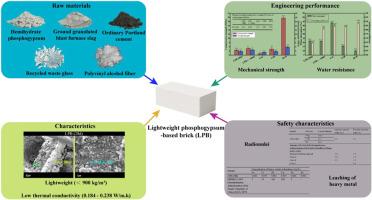Valorization of industrial by-product gypsum for sustainable lightweight brick: Performance, microstructure and environmental safety assessments
IF 5.8
2区 化学
Q2 CHEMISTRY, MULTIDISCIPLINARY
引用次数: 0
Abstract
Sustainable development and the utilization of renewable resources are crucial for addressing environmental degradation and resource depletion, particularly in the construction industry. Bricks are one of the common construction materials, and their production has a substantial environmental impact. Phosphogypsum (PG), an industrial by-product gypsum with low recycling rates, is being explored as an alternative material for bricks. This study aims to conduct a comprehensive assessment of a novel lightweight PG-based brick (LPB), focusing on its engineering performance and environmental safety as a critical scientific evaluation prior to industrial application. The evaluation emphasizes the brick's service performance and safety characteristics. Additionally, the properties of the produced LPB were compared with three different types of commercial bricks, namely autoclaved aerated concrete (AAC) brick, cement sand brick (CSB), and red clay brick (RCB). The results demonstrate that LPB exhibits compressive strength (5.2 MPa) comparable to that of AAC bricks and CSB, along with good water resistance. Although LPB has a lower compressive strength than RCB, its lightweight nature (890 kg/m3) offers distinct advantages. Furthermore, the leachability of heavy metals from LPB, as well as the content of radionuclides in LPB, are below the limits outlined in GB 5085.3–2007 and GB 6566-2010, respectively. Therefore, LPB is suggested to be a viable brick option for non-load bearing applications in the construction industry without causing adverse environmental impacts. The research output can contribute to the promotion of sustainable building materials and the efficient utilization of PG resources.

可持续轻量化砖用工业副产品石膏的增值:性能、微观结构和环境安全评估
可持续发展和利用可再生资源是解决环境退化和资源枯竭问题的关键,特别是在建筑工业方面。砖是常见的建筑材料之一,其生产对环境有重大影响。磷石膏(PG)是一种回收率低的工业副产品石膏,目前正在探索作为砖的替代材料。本研究旨在对一种新型轻质pg基砖(LPB)进行综合评估,重点关注其工程性能和环境安全性,作为工业应用之前的关键科学评估。评价强调砖的使用性能和安全特性。此外,还将生产的LPB与三种不同类型的商品砖,即蒸压加气混凝土砖(AAC)、水泥砂砖(CSB)和红粘土砖(RCB)的性能进行了比较。结果表明:LPB具有与AAC砖和CSB相当的抗压强度(5.2 MPa),且具有良好的耐水性;虽然LPB的抗压强度低于RCB,但其轻质特性(890 kg/m3)具有明显的优势。铅铅的重金属浸出率和放射性核素含量均低于GB 5085.3-2007和GB 6566-2010标准。因此,建议LPB作为建筑行业非承重应用的可行砖选择,而不会对环境造成不利影响。研究成果有助于促进可持续建筑材料的推广和PG资源的高效利用。
本文章由计算机程序翻译,如有差异,请以英文原文为准。
求助全文
约1分钟内获得全文
求助全文
来源期刊

Sustainable Chemistry and Pharmacy
Environmental Science-Pollution
CiteScore
8.20
自引率
6.70%
发文量
274
审稿时长
37 days
期刊介绍:
Sustainable Chemistry and Pharmacy publishes research that is related to chemistry, pharmacy and sustainability science in a forward oriented manner. It provides a unique forum for the publication of innovative research on the intersection and overlap of chemistry and pharmacy on the one hand and sustainability on the other hand. This includes contributions related to increasing sustainability of chemistry and pharmaceutical science and industries itself as well as their products in relation to the contribution of these to sustainability itself. As an interdisciplinary and transdisciplinary journal it addresses all sustainability related issues along the life cycle of chemical and pharmaceutical products form resource related topics until the end of life of products. This includes not only natural science based approaches and issues but also from humanities, social science and economics as far as they are dealing with sustainability related to chemistry and pharmacy. Sustainable Chemistry and Pharmacy aims at bridging between disciplines as well as developing and developed countries.
 求助内容:
求助内容: 应助结果提醒方式:
应助结果提醒方式:


